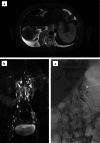Interventional treatment of refractory non-traumatic chylous effusions in patients with lymphoproliferative disorders
- PMID: 38554229
- PMCID: PMC10981590
- DOI: 10.1007/s10238-024-01312-4
Interventional treatment of refractory non-traumatic chylous effusions in patients with lymphoproliferative disorders
Abstract
To report results of interventional treatment of refractory non-traumatic abdomino-thoracic chylous effusions in patients with lymphoproliferative disorders. 17 patients (10 male; mean age 66.7 years) with lymphoproliferative disorders suffered from non-traumatic chylous effusions (chylothorax n = 11, chylous ascites n = 3, combined abdomino-thoracic effusion n = 3) refractory to chemotherapy and conservative therapy. All underwent x-ray lymphangiography with iodized-oil to evaluate for and at the same time treat lymphatic abnormalities (leakage, chylo-lymphatic reflux with/without obstruction of central drainage). In patients with identifiable active leakage additional lymph-vessel embolization was performed. Resolution of effusions was deemed as clinical success. Lymphangiography showed reflux in 8/17 (47%), leakage in 2/17 (11.8%), combined leakage and reflux in 3/17 (17.6%), lymphatic obstruction in 2/17 (11.8%) and normal findings in 2/17 cases (11.8%). 12/17 patients (70.6%) were treated by lymphangiography alone; 5/17 (29.4%) with leakage received additional embolization (all technically successful). Effusions resolved in 15/17 cases (88.2%); 10/12 (83.3%) resolved after lymphangiography alone and in 5/5 patients (100%) after embolization. Time-to-resolution of leakage was significantly shorter after embolization (within one day in all cases) than lymphangiography (median 9 [range 4-30] days; p = 0.001). There was no recurrence of symptoms or post-interventional complications during follow-up (median 445 [40-1555] days). Interventional-radiological treatment of refractory, non-traumatic lymphoma-induced chylous effusions is safe and effective. Lymphangiography identifies lymphatic abnormalities in the majority of patients and leads to resolution of effusions in > 80% of cases. Active leakage is found in only a third of patients and can be managed by additional embolization.
Keywords: Chylothorax; Chylous ascites; Embolization; Lymphangiography; Lymphoproliferative disorders.
© 2024. The Author(s).
Conflict of interest statement
There are no financial arrangements that could be regarded as a conflict of interest in connection with the present work. Financial connections outside the present work: JAL: Speakers Bureau: Philips Healthcare (Netherlands), Bayer Vital (Germany); UIA: Speakers Bureau: Siemens Healthineers (Erlangen, Germany), CCP: Speakers Bureau: Philips Healthcare (Best, Netherlands), Bayer Vital (Germany), Guerbet (France), Julius Zorn GmbH (Germany).
Figures


Similar articles
-
Long-Term Clinical Outcome of Abdomino-Thoracic Lymphatic Interventions of Traumatic and Non-Traumatic Lymphatic Leakage in Adults.Biomedicines. 2023 Sep 18;11(9):2556. doi: 10.3390/biomedicines11092556. Biomedicines. 2023. PMID: 37760997 Free PMC article.
-
Lymphatic interventions for isolated, iatrogenic chylous ascites: A multi-institution experience.Eur J Radiol. 2018 Dec;109:41-47. doi: 10.1016/j.ejrad.2018.10.019. Epub 2018 Oct 25. Eur J Radiol. 2018. PMID: 30527310
-
Endolymphatic Interventions for the Treatment of Chylothorax and Chylous Ascites in Neonates: Technical and Clinical Success and Complications.Ann Vasc Surg. 2018 Jul;50:269-274. doi: 10.1016/j.avsg.2018.01.097. Epub 2018 Mar 7. Ann Vasc Surg. 2018. PMID: 29524461
-
Lymphangiography to treat postoperative lymphatic leakage: a technical review.Korean J Radiol. 2014 Nov-Dec;15(6):724-32. doi: 10.3348/kjr.2014.15.6.724. Epub 2014 Nov 7. Korean J Radiol. 2014. PMID: 25469083 Free PMC article. Review.
-
Novel interventional radiological management for lymphatic leakages after gynecologic surgery: lymphangiography and embolization.Gland Surg. 2021 Mar;10(3):1260-1267. doi: 10.21037/gs-2019-ursoc-10. Gland Surg. 2021. PMID: 33842273 Free PMC article. Review.
Cited by
-
Real-Time Identification of Lymph Vessels Using Indocyanine Green in a Patient With Chylothorax Associated With Lymphangioleiomyomatosis.Asian J Endosc Surg. 2025 Jan-Dec;18(1):e70067. doi: 10.1111/ases.70067. Asian J Endosc Surg. 2025. PMID: 40254818 Free PMC article.
-
Pediatric Chylothorax Treated With Lymphangiography and Thoracic Duct Embolization: A Case Report.Cureus. 2024 Jul 6;16(7):e63981. doi: 10.7759/cureus.63981. eCollection 2024 Jul. Cureus. 2024. PMID: 39105012 Free PMC article.
-
Bilateral Patent Processus Vaginalis with Chylous Effusion in a Pediatric Patient: A Rare Case Report and Literature Review.J Inflamm Res. 2024 Nov 27;17:9917-9923. doi: 10.2147/JIR.S499301. eCollection 2024. J Inflamm Res. 2024. PMID: 39624398 Free PMC article.
References
-
- Fukumoto A, Terao T, Kuzume A, Tabata R, Tsushima T, Miura D, Ikeda D, Kamura Y, Narita K, Takeuchi M, Matsue K. Management of lymphoma-associated chylothorax by interventional radiology and chemotherapy: a report of five cases. Int J Hematol. 2022;116:579–85. 10.1007/s12185-022-03397-7. - PubMed
-
- Staats BA, Ellefson RD, Budahn LL, Dines DE, Prakash UB, Offord K. The lipoprotein profile of chylous and nonchylous pleural effusions. Mayo Clin Proc. 1980;55:700–4. - PubMed
-
- Pieper CC, Hur S, Sommer CM, Nadolski G, Maleux G, Kim J, Itkin M. Back to the future: lipiodol in lymphography-from diagnostics to theranostics. Invest Radiol. 2019;54:600–15. 10.1097/RLI.0000000000000578. - PubMed
-
- Pieper CC. Back to the future II-a comprehensive update on the rapidly evolving field of lymphatic imaging and interventions. Invest Radiol. 2023;58:610–40. 10.1097/RLI.0000000000000966. - PubMed
MeSH terms
LinkOut - more resources
Full Text Sources

